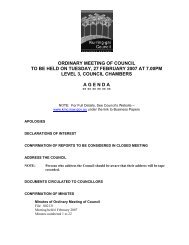Pymble Business Park - Ku-ring-gai Council
Pymble Business Park - Ku-ring-gai Council
Pymble Business Park - Ku-ring-gai Council
Create successful ePaper yourself
Turn your PDF publications into a flip-book with our unique Google optimized e-Paper software.
6.2 EARTHWORKS AND SLOPE<br />
Objectives<br />
1 To respect the natural<br />
topography of a site.<br />
2 To maintain the health of<br />
existing trees.<br />
3 To maintain subsurface<br />
and groundwater flows<br />
and direction.<br />
4 To minimise downstream<br />
impacts from erosion and<br />
sedimentation or altered<br />
water flows due to site<br />
earthworks or retaining<br />
walls.<br />
5 To ensure that<br />
development is designed<br />
conside<strong>ring</strong> the stability<br />
of the land on which it is<br />
located.<br />
6 To prevent damage to<br />
buildings and structures<br />
on adjoining land.<br />
7 To minimise excavated<br />
materials going off site.<br />
8 To minimise land<br />
degradation, water<br />
pollution and damage<br />
to infrastructure from<br />
erosion and accumulated<br />
sediment.<br />
Controls<br />
1 Development must demonstrate consideration of site topography,<br />
drainage, soil landscapes, flora, fauna and bushfire hazard.<br />
2 Development must be accommodated within the natural slope of<br />
the land. Level changes across the site are to be primarily resolved<br />
within the building footprint. This may be achieved by:<br />
i) stepping buildings down a site;<br />
ii) locating the finished ground floor level as close to existing<br />
ground level as practicable.<br />
3 Development is to minimise earthworks on steeply sloping sites.<br />
Note: Sites with a slope in excess of 15% may require certifi cation from a<br />
geotechnical engineer as to the stability of the slope in regard to the proposed<br />
design.<br />
4 A minimum 0.6m width is required between retaining walls to provide<br />
adequate soil area and depth to ensure that they do not read as a<br />
single level change, and for the viability of landscaping.<br />
Note: A minimum width of 2m is required between retaining walls for this area to be<br />
included in deep soil calculations.<br />
5 Existing ground level is to be maintained for a distance of 2m from<br />
any boundary.<br />
6 Grassed embankments are not to exceed a 1:6 slope. Vegetated<br />
embankments, planted with soil stabilising species, may be to a<br />
maximum of 1:3.<br />
7 Fill and excavation are not permitted within sensitive environments,<br />
such as riparian lands, bushland, or significant vegetation.<br />
Note: A plan demonstrating the extent of batters or sho<strong>ring</strong> in the vicinity of sensitive<br />
environments prepared by a suitably qualifi ed engineer, will be required.<br />
8 Retaining walls, excavated and filled areas shall be located and<br />
constructed to have no adverse impact on:<br />
i) structures to be retained on the site;<br />
ii) structures on adjacent public or private land;<br />
iii) trees to be retained on site or on adjoining sites.<br />
rear/ side boundary<br />
Single<br />
Dwelling<br />
Residential<br />
Basement<br />
<strong>Park</strong>ing<br />
2m<br />
2m<br />
max 0.9m<br />
retaining walls<br />
p 54<br />
Draft <strong>Ku</strong>-<strong>ring</strong>-<strong>gai</strong> <strong>Pymble</strong> Buiness <strong>Park</strong> Control Plan 2012<br />
Figure 6.2-1:<br />
Retaining walls, terraces and ground lines at boundaries.

















